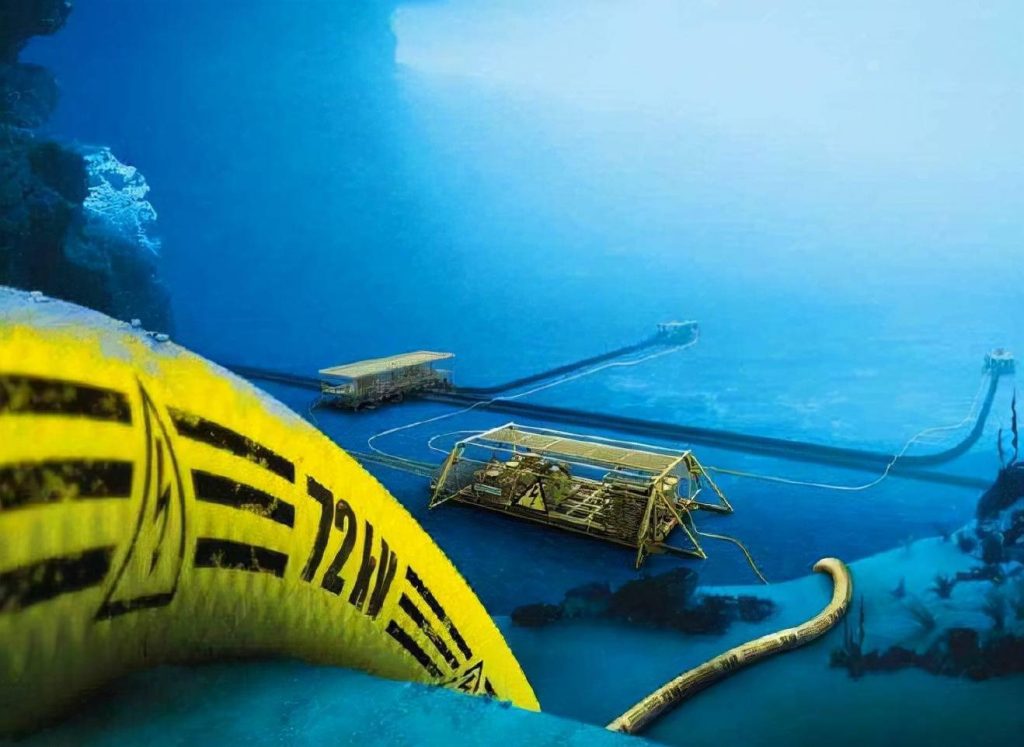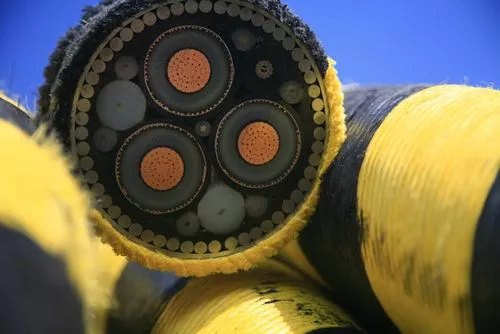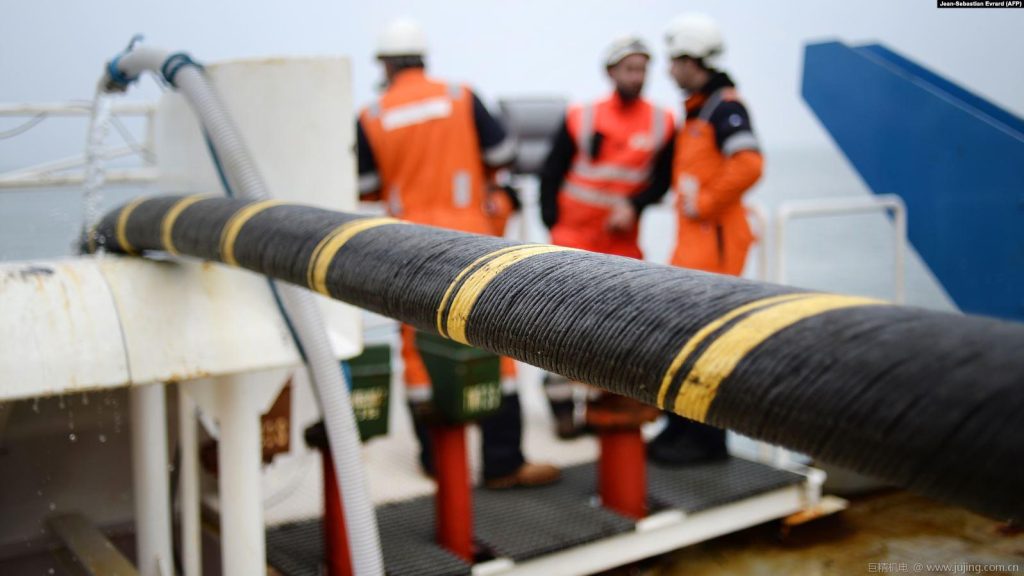The fundamental reason: the capacitive current of AC cables limits their transmission distance. This is for long-distance submarine projects, the transmission of large power is very difficult. Submarine DC cables have no capacitive current, transmission capacity is not limited by distance. So only a DC cable can be used to transmit power.
From the beginning of last year until now, the Russian-Ukrainian conflict, the Palestinian-Israeli conflict and so on broke out one after another. In these wars and conflicts, aerial cables, concentric cables, submarine cables and so on all play different degrees of important role.
Submarine power cables are key facilities connecting power systems in different countries and regions, and are strategically important.
The Role of Submarine DC Communication Cable

A submarine communication cable is a specialized cable laid on the seabed for submarine communication and data transmission. It plays an important role in the field of modern communications and the Internet and has several major uses:
International Communications
Submarine communication cables are the infrastructure of international communication networks connecting all parts of the world.
They carry international communications traffic for international telephone, Internet, video, television, and other digital communications services.
Network Interconnection
Submarine telecommunication cables create an interconnected global Internet infrastructure between regions and countries.
They enable fast, stable data transmission and interconnection for Internet users worldwide.
Data Transmission
Submarine communication cables are key to the transmission of large amounts of data.
Submarine cables provide high bandwidth and low-latency connectivity. They are widely used for interconnecting data centers, cloud computing, and big data transmission.
Scientific Research
Submarine communication cables also provide an important data transfer and communication base for marine scientific research.
Scientists can transmit and share scientific research information such as ocean observations, and seismic monitoring. And meteorological data in real-time through submarine communication cable systems.
Energy Interconnection
Some submarine cables are also used to transmit power generation capacity from renewable energy sources, such as offshore wind and ocean energy, to realize energy interconnection and power transmission.
Submarine communication cables play a vital role in international communications, network interconnections, data transmission, scientific research, and energy interconnections, providing reliable submarine connectivity for global communications and data exchange.
About Submarine DC Cables

DC cables are power cables used in DC power transmission and distribution systems.
The DC power cables have the same structure as AC cables except that the electrical characteristics of operation are different from those of AC.
DC cables are mainly used in long-distance submarine cable lines.
The Difference between DC and AC Cables
DC and AC cables are compared with the following characteristics
Different Systems are Used
DC cables are used in rectified DC transmission systems, and AC cables are commonly used in industrial frequency power systems.
Different Power Loss
DC cables have less power loss during transmission compared to AC cables.
DC wire power loss is mainly the DC resistance loss of the conductor, insulation loss is small, and the size depends on the rectified current fluctuations.
The AC resistance of low-voltage AC cables is slightly larger than the DC resistance.
High-voltage cables are more obvious, mainly due to the proximity effect and skin effect, the loss of insulation resistance accounts for a large proportion of the impedance generated mainly by capacitance and inductance.
Low Cost of Use
Although the price of variable current equipment is higher than the transformer, the cost of using cable lines is much lower than AC cables.
DC cable has positive and negative poles and a simple structure.
AC cable is a three-phase four-wire or five-wire system, with high insulation safety requirements, complex structure, and cable costs more than three times DC cable.
DC Cable has High-Safety
- The inherent characteristics of DC transmission make it less likely to produce induced currents and leakage currents, and will not produce electric field interference to other cables laid in the same way.
- Single-core laid cables will not affect the transmission performance of cables due to hysteresis loss of steel bridges.
- Compared with DC cables of the same structure, it has a higher current cutoff capability and over-interruption protection capability.
- When DC and AC electric fields of the same voltage are applied to an insulator, DC electric fields are much safer than AC electric fields.
When AC and DC electric fields of the same voltage are applied to the insulation, the DC electric field of the cable is much smaller than the AC electric field.
Due to the large difference in the structure of the two electric fields, the maximum electric field when AC cables are energized is concentrated near the conductor.
DC cable is energized when the maximum electric field is mainly concentrated in the insulation surface, so it is safer.
Submarine Cable Product Innovation Led to the Production of DC Cable
Compared with the traditional AC submarine cable DC submarine cable has the advantage of
In submarine cables for long-distance high-capacity power transmission, the DC transmission conductor root number is small, and the resistance of the heat loss is relatively small.
So submarine DC cable is particularly suitable for renewable energy, islands in the ocean, offshore platforms, and other power transmission.
It greatly improves the energy-saving effect in power transmission and has practical economic and technical significance in reducing carbon dioxide emissions.
XLPE DC Submarine Cable Advantages
XLPE DC submarine cable in the laying process requires a narrow line corridor, which can save installation costs. Reduces the amount of cable engineering construction by 1/3, and cable routing occupies less than 1/2 of the seabed space.
Using seawater as the grounding electrode circuit can also save the investment in land grounding electrodes.
In addition to the landing lot, most of the cables in a certain test of the seabed, to make up for the receipt of wind and waves and other natural environmental damage and human production activities of interference.
So the cable is safe and stable, has good confidentiality performance, and can be connected to different frequencies around the neighboring countries or regions of the power grid.
Can be realized by isolating the sea at both ends of the power system failure, to avoid interconnection of the power grid large-scale blackout.
Although the sea cable transmission capacity is, a small loss, seawater heat dissipation is fast. So the degree of thermal aging damage to the insulation of the sea cable is greatly reduced.
ZMS High-Voltage XLPE DC Submarine Cable Development and Technological Innovation

Product Structure Design
The maximum working temperature of the conductor is 70°C, and the permissible temperature of the conductor is 160°C in case of short-circuit (5s).
The cable is designed to operate within the insulation with a maximum temperature difference of 20°C.
Insulation field strength is limited to 20kV/mm, customized to 30kV/mm as supplied by the customer.
Calculation and checking of insulation thickness based on these parameters to design safe and reliable insulation thickness.
Manufacturing of Large Cross-Section Conductors
Design of two sets of solutions: one-time stranding and layered stranding.
Through trial production, we finally chose the layered stranding process to complete the production of 1000 mm2, 1600 mm2, and 1800 mm2 large cross-section conductors. Which is the first hurdle for the trial production of XLPE DC submarine cables.
Insulation Extrusion Process
Due to the uneven distribution of by-products within the insulation of DC submarine cables, internal defects containing micropores, impurities, etc. This can cause the collection of space charge in the operation of the product, resulting in cable failure.
Flexible Joint Design and Production
zms cable manufacturers have extensive experience in this area of production. Due to the difference between DC and AC operation mechanisms. The experience of XLPE AC submarine cable flexible joints can’t be exactly copied. Therefore, ZMS cable has built a clean operation room of 1,000 grade for making flexible joints for high-voltage standards. Equipped with special tooling and molds, and experienced production personnel, adopting the molding process. Through cooperation with domestic authoritative scientific research institutes, we have successfully designed XLPE DC submarine cable flexible joints production and testing programs to ensure that the joints and the body of the cable with close to the same mechanical properties and electrical properties.
We have completed the production of flexible joints for submarine cables with voltage levels of ±160kV, ±200kV, and ±320kV, and passed the relevant tests.
We hope this article about DC submarine cables will help you in the purchase of submarine cables.ZMS as an experienced cable manufacturer, faces the challenges directly. Improves its own innovation ability, and seizes the peak of DC transmission technology. It also endeavors to strengthen communication with customers and understand the needs and development trends of customers and the market. We actively cooperate with senior enterprises in the same industry to overcome the difficulties encountered in the production process.
